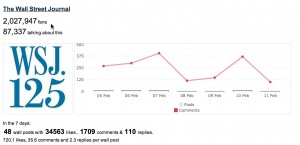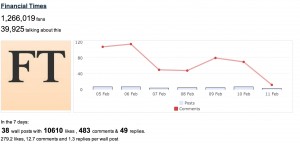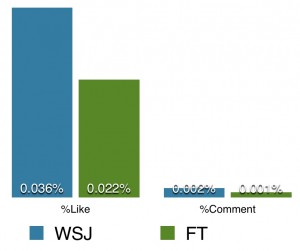Recently, eConsultancy published a blog post called “How The Wall Street Journal owns social media through Facebook and Twitter“. The author compared WSJ’s number of Facebook likes and Twitter Followers with those of Financial Times and Bloomberg News and concluded that WSJ is dominating Financial Times and Bloomberg News when it comes to social media. While this is a good article, it reminds me of how we should evaluate the success of our social media effort, should we base it solely on the number of likes/twitter follower?
1. We should look beyond the number of likes on Facebook and followers on Twitter
To me, the total number of like or follower is important but more importantly, when we compare, we need to look at reach and engagement.
As you may know, while WSJ’s total fan base on Facebook could be 2M, it is not like every time they post something, all of the 2M fan would see what they post. In other words, if the post only appears on the news feed for 80k fan organically, their reach is only 80k. Of course, when someone likes/comments/shares on the post, their friend would potentially see the post as well but you get my idea. We need to compare average reach per post between WSJ, FT or Bloomberg News. We could measure in absolute value or in percentage. I think percentage is better in this case.
Secondly, it’s about engagement and engagement is measured by the average number of likes/comments/share per post. Because bigger fanbase does not equal greater engagement as a percentage and basically we want to have highly engaged community.
Below is the number for WSJ Facebook and Financial Times.
Basically WSJ has more likes and comments per post on their Facebook page for the past 7 days.
As percentage of their fanbase:
Base on the above number, we could see that WSJ Facebook fanpage is 2X more engaging than the FT’s.
However, there is one caveat that is we don’t know whether WSJ or FT used Paid media to promote their posts over the past 7 days. From my experience the like rate of 0.0X% suggests that they didn’t use Paid Media (Facebook ad basically) over the past 7 days to increase their post engagement but we don’t know for sure.
Also, we don’t know how much money WSJ spent on running Facebook ads to acquire new fans etc..
2. How Social Media drives the bottom line?
To me, any marketing activity should have a revenue goal attached to it. Otherwise, how do we justify the time & resources (human resources, budget) allocated to it?
It is hard for the author of the article to compare the revenue generated from social media activities for WSJ, the FT or Bloomberg, I realize. However, if I am going to measure it, I would start with a few things like:
- The number of visits driven by different social media platform? (This information could be found using Google Analytics or any other onsite Analytics tools).
One example is below (it’s NOT from WSJ or the FT though because I don’t have their data).
- Or we could measure the direct impact on the bottom line (again with conversion tracking/revenue tracking set up on Google Analytics or other similar tools). Another example is below:
As you can see from the screenshot above, from Analytics tool, we know how much revenue is driven by Social media as a channel, how many conversions it brings etc… They even provide information like the number of conversions based on last interaction vs contributed number of conversions.
In summary, I think we have a good article posted by Christopher Ratcliff. The main focus of the article is to share some tips behind the success of WSJ over its competitors when it comes to social media. However, if I were the marketing manager for WSJ, I would certainly dig much deeper to see how I do against competitors 🙂
P.S: Avinash Kaushik wrote a beautiful piece about Social media ROI as well.
P.P.S: I covered this in the section about Social Media in my book “Vietnam Digital Marketing Fundamentals” as well.




